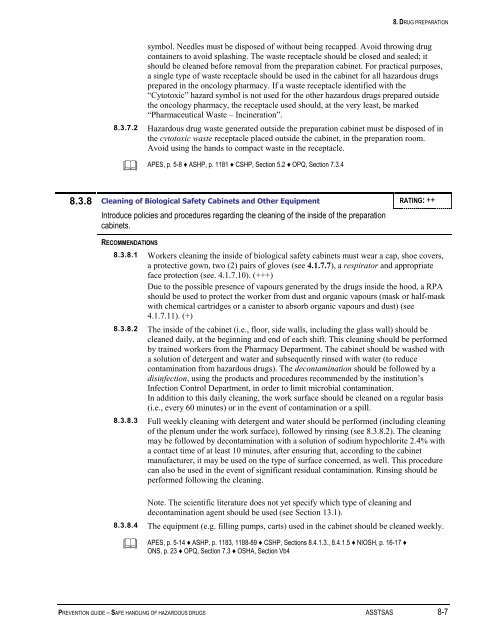Prevention Guide - Safe Handling of Hazardous Drugs - Irsst
Prevention Guide - Safe Handling of Hazardous Drugs - Irsst
Prevention Guide - Safe Handling of Hazardous Drugs - Irsst
Create successful ePaper yourself
Turn your PDF publications into a flip-book with our unique Google optimized e-Paper software.
8. DRUG PREPARATION<br />
symbol. Needles must be disposed <strong>of</strong> without being recapped. Avoid throwing drug<br />
containers to avoid splashing. The waste receptacle should be closed and sealed; it<br />
should be cleaned before removal from the preparation cabinet. For practical purposes,<br />
a single type <strong>of</strong> waste receptacle should be used in the cabinet for all hazardous drugs<br />
prepared in the oncology pharmacy. If a waste receptacle identified with the<br />
“Cytotoxic” hazard symbol is not used for the other hazardous drugs prepared outside<br />
the oncology pharmacy, the receptacle used should, at the very least, be marked<br />
“Pharmaceutical Waste – Incineration”.<br />
8.3.7.2 <strong>Hazardous</strong> drug waste generated outside the preparation cabinet must be disposed <strong>of</strong> in<br />
the cytotoxic waste receptacle placed outside the cabinet, in the preparation room.<br />
Avoid using the hands to compact waste in the receptacle.<br />
<br />
APES, p. 5-8 ♦ ASHP, p. 1181 ♦ CSHP, Section 5.2 ♦ OPQ, Section 7.3.4<br />
8.3.8 Cleaning <strong>of</strong> Biological <strong>Safe</strong>ty Cabinets and Other Equipment RATING: ++<br />
Introduce policies and procedures regarding the cleaning <strong>of</strong> the inside <strong>of</strong> the preparation<br />
cabinets.<br />
RECOMMENDATIONS<br />
8.3.8.1 Workers cleaning the inside <strong>of</strong> biological safety cabinets must wear a cap, shoe covers,<br />
a protective gown, two (2) pairs <strong>of</strong> gloves (see 4.1.7.7), a respirator and appropriate<br />
face protection (see. 4.1.7.10). (+++)<br />
Due to the possible presence <strong>of</strong> vapours generated by the drugs inside the hood, a RPA<br />
should be used to protect the worker from dust and organic vapours (mask or half-mask<br />
with chemical cartridges or a canister to absorb organic vapours and dust) (see<br />
4.1.7.11). (+)<br />
8.3.8.2 The inside <strong>of</strong> the cabinet (i.e., floor, side walls, including the glass wall) should be<br />
cleaned daily, at the beginning and end <strong>of</strong> each shift. This cleaning should be performed<br />
by trained workers from the Pharmacy Department. The cabinet should be washed with<br />
a solution <strong>of</strong> detergent and water and subsequently rinsed with water (to reduce<br />
contamination from hazardous drugs). The decontamination should be followed by a<br />
disinfection, using the products and procedures recommended by the institution’s<br />
Infection Control Department, in order to limit microbial contamination.<br />
In addition to this daily cleaning, the work surface should be cleaned on a regular basis<br />
(i.e., every 60 minutes) or in the event <strong>of</strong> contamination or a spill.<br />
8.3.8.3 Full weekly cleaning with detergent and water should be performed (including cleaning<br />
<strong>of</strong> the plenum under the work surface), followed by rinsing (see 8.3.8.2). The cleaning<br />
may be followed by decontamination with a solution <strong>of</strong> sodium hypochlorite 2.4% with<br />
a contact time <strong>of</strong> at least 10 minutes, after ensuring that, according to the cabinet<br />
manufacturer, it may be used on the type <strong>of</strong> surface concerned, as well. This procedure<br />
can also be used in the event <strong>of</strong> significant residual contamination. Rinsing should be<br />
performed following the cleaning.<br />
Note. The scientific literature does not yet specify which type <strong>of</strong> cleaning and<br />
decontamination agent should be used (see Section 13.1).<br />
8.3.8.4 The equipment (e.g. filling pumps, carts) used in the cabinet should be cleaned weekly.<br />
<br />
APES, p. 5-14 ♦ ASHP, p. 1183, 1188-89 ♦ CSHP, Sections 8.4.1.3., 8.4.1.5 ♦ NIOSH, p. 16-17 ♦<br />
ONS, p. 23 ♦ OPQ, Section 7.3 ♦ OSHA, Section Vb4<br />
PREVENTION GUIDE – SAFE HANDLING OF HAZARDOUS DRUGS ASSTSAS 8-7

















